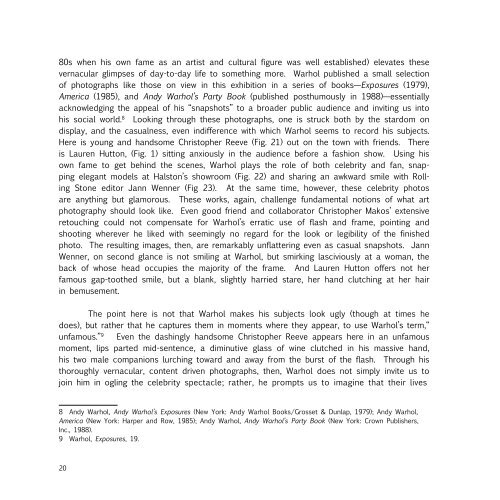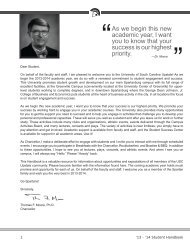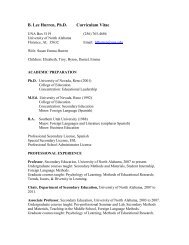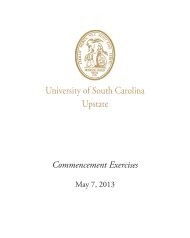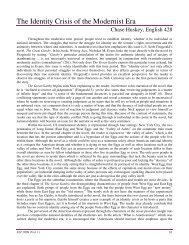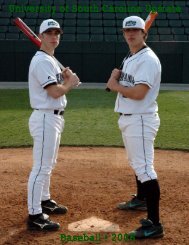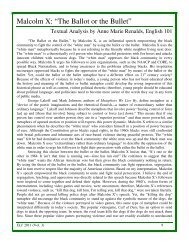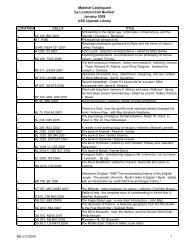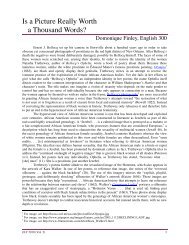The Andy Warhol Photographic - University of South Carolina Upstate
The Andy Warhol Photographic - University of South Carolina Upstate
The Andy Warhol Photographic - University of South Carolina Upstate
Create successful ePaper yourself
Turn your PDF publications into a flip-book with our unique Google optimized e-Paper software.
80s when his own fame as an artist and cultural figure was well established) elevates these<br />
vernacular glimpses <strong>of</strong> day-to-day life to something more. <strong>Warhol</strong> published a small selection<br />
<strong>of</strong> photographs like those on view in this exhibition in a series <strong>of</strong> books—Exposures (1979),<br />
America (1985), and <strong>Andy</strong> <strong>Warhol</strong>’s Party Book (published posthumously in 1988)—essentially<br />
acknowledging the appeal <strong>of</strong> his “snapshots” to a broader public audience and inviting us into<br />
his social world. 8 Looking through these photographs, one is struck both by the stardom on<br />
display, and the casualness, even indifference with which <strong>Warhol</strong> seems to record his subjects.<br />
Here is young and handsome Christopher Reeve (Fig. 21) out on the town with friends. <strong>The</strong>re<br />
is Lauren Hutton, (Fig. 1) sitting anxiously in the audience before a fashion show. Using his<br />
own fame to get behind the scenes, <strong>Warhol</strong> plays the role <strong>of</strong> both celebrity and fan, snapping<br />
elegant models at Halston’s showroom (Fig. 22) and sharing an awkward smile with Rolling<br />
Stone editor Jann Wenner (Fig 23). At the same time, however, these celebrity photos<br />
are anything but glamorous. <strong>The</strong>se works, again, challenge fundamental notions <strong>of</strong> what art<br />
photography should look like. Even good friend and collaborator Christopher Makos’ extensive<br />
retouching could not compensate for <strong>Warhol</strong>’s erratic use <strong>of</strong> flash and frame, pointing and<br />
shooting wherever he liked with seemingly no regard for the look or legibility <strong>of</strong> the finished<br />
photo. <strong>The</strong> resulting images, then, are remarkably unflattering even as casual snapshots. Jann<br />
Wenner, on second glance is not smiling at <strong>Warhol</strong>, but smirking lasciviously at a woman, the<br />
back <strong>of</strong> whose head occupies the majority <strong>of</strong> the frame. And Lauren Hutton <strong>of</strong>fers not her<br />
famous gap-toothed smile, but a blank, slightly harried stare, her hand clutching at her hair<br />
in bemusement.<br />
<strong>The</strong> point here is not that <strong>Warhol</strong> makes his subjects look ugly (though at times he<br />
does), but rather that he captures them in moments where they appear, to use <strong>Warhol</strong>’s term,“<br />
unfamous.” 9 Even the dashingly handsome Christopher Reeve appears here in an unfamous<br />
moment, lips parted mid-sentence, a diminutive glass <strong>of</strong> wine clutched in his massive hand,<br />
his two male companions lurching toward and away from the burst <strong>of</strong> the flash. Through his<br />
thoroughly vernacular, content driven photographs, then, <strong>Warhol</strong> does not simply invite us to<br />
join him in ogling the celebrity spectacle; rather, he prompts us to imagine that their lives<br />
are no more exceptional then our own, and thus, that the lines between celebrity and everyday<br />
life are entirely permeable. In <strong>Warhol</strong>’s thoroughly inclusive photographic record, everyone and<br />
everything finds itself on strikingly equal footing.<br />
Both the Polaroids and the black-and-white photographs <strong>of</strong> celebrity culture establish an<br />
interdependence between the extremes <strong>of</strong> celebrity artifice and performance on the one hand<br />
and the realm <strong>of</strong> the quotidian on the other. <strong>Warhol</strong>’s celebrity subjects are relatable because<br />
they are both famous and unfamous (and so, potentially, are his viewers). <strong>The</strong> same applies<br />
to <strong>Warhol</strong> himself. In his many self-portraits, books, and interviews, <strong>Warhol</strong> performs a kind<br />
<strong>of</strong> aesthetic inscrutability, transforming himself into an ethereal icon, all vapid mien and silver<br />
wig. This is the <strong>Warhol</strong> most <strong>of</strong> us are familiar with, yet looking through this exhibition we<br />
encounter a different <strong>Warhol</strong>, a living, breathing, desiring <strong>Warhol</strong> who reveals his extraordinary<br />
ordinariness through his photographic habits. Particularly significant in this regard are the<br />
photographs that address <strong>Warhol</strong>’s sexual desires. Most emphatic among these are the sex<br />
pictures, Polaroids <strong>of</strong> male genitals and sex acts (<strong>of</strong>ten between friend Victor Hugo and men<br />
that he picked up in bars and brought to the Factory for <strong>Warhol</strong>’s pornographic photo sessions)<br />
that were, according to accounts by Colacello, a somewhat routine practice for <strong>Warhol</strong>. 10 Yet<br />
<strong>Warhol</strong>’s private life and desires emerge as well in his black-and-white snapshots <strong>of</strong> handsome<br />
young men eating, drinking, and socializing and the many photographs <strong>of</strong> <strong>Warhol</strong>’s boyfriend<br />
Jon Gould (according to William Ganis, <strong>Warhol</strong>’s single most frequent photographic subject)<br />
(Fig. 24, 25). <strong>Warhol</strong>’s “swishy” persona was something <strong>of</strong> an anomaly in the art world <strong>of</strong><br />
the 1960s when he first made a name for himself as an artist. Even gay contemporaries like<br />
Jasper Johns and Robert Rauschenberg (the latter featured here in a suggestive photograph<br />
relieving himself in a men’s bathroom) (Fig. 26) played it relatively straight in public. But here,<br />
<strong>Warhol</strong>’s queer desires are explicit and unapologetic, forcing us to acknowledge the complexity<br />
<strong>of</strong> his own enigmatic celebrity persona and the impulses and intimacies that lie beneath it.<br />
In his consideration <strong>of</strong> <strong>Warhol</strong>’s life-long fascination with documentary technologies<br />
(tape recorders, movie cameras, and <strong>of</strong> course, photography), Jonathan Flatley has argued that<br />
the camera, for <strong>Warhol</strong>, was essentially a machine “for liking.” 11 In so doing, Flatley suggests<br />
8 <strong>Andy</strong> <strong>Warhol</strong>, <strong>Andy</strong> <strong>Warhol</strong>’s Exposures (New York: <strong>Andy</strong> <strong>Warhol</strong> Books/Grosset & Dunlap, 1979); <strong>Andy</strong> <strong>Warhol</strong>,<br />
America (New York: Harper and Row, 1985); <strong>Andy</strong> <strong>Warhol</strong>, <strong>Andy</strong> <strong>Warhol</strong>’s Party Book (New York: Crown Publishers,<br />
Inc., 1988).<br />
9 <strong>Warhol</strong>, Exposures, 19.<br />
10 Bob Colacello, Holy Terror: <strong>Andy</strong> <strong>Warhol</strong> Close Up (New York: HarperCollins, 1990), 344.<br />
11 Jonathan Flatley, “Art Machine,” Sol Lewitt: Incomplete Open Cubes (Hartford: Wadsworth Athaneum Museum <strong>of</strong><br />
Art, 2001), 86-7. Flatley has expanded upon the conceptual, social, and political implications <strong>of</strong> <strong>Warhol</strong>’s unique<br />
capacity for “liking” in his more recent essay, “Like: Collecting and Collectivity,” October 132 (2010): 71-98.<br />
20<br />
21


